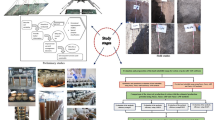Abstract
Land evaluation is the process of predicting land-use potential on the basis of its attributes. In the present study, the qualitative land suitability evaluation by parametric and fuzzy approaches was investigated for sugar beet crop in Sabzevar plain, Northeast of Iran. Our results indicated that the most limiting factor for sugar beet cultivation in the study area is soil organic carbon. In both models, the suitability classes for sugar beet cultivation were classified into high (S1) in north parts of the plain to moderate suitable (S2) due to lower values of soil organic carbon in southwest and scattered part in the center of the plain. The values of land indexes by parametric and fuzzy logic approaches ranged from 60.55 and 50.50 in some parts in the center and south west to 84.95 and 83.20 in the northern parts of the plain, respectively. The coefficient of determination between the results obtained from both models was R 2 = 0.995, which shows a high correlation between the calculated land index values from two approaches. The correlation coefficient between the land index values and the observed sugar beet yield (R 2) varied between 0.86 and 0.94 by parametric and fuzzy approaches which verify the validation of both models in estimating land suitability for sugar beet production in the study area.






Similar content being viewed by others
References
Bagherzadeh A, Mansouri Daneshvar MR (2011) Physical land suitability evaluation for specific cereal crops using GIS at Mashhad Plain, Northeast of Iran. Front Agric China 5(4):90–100
Bagherzadeh A, Paymard P (2015) Assessment of land capability for different irrigation systems by parametric and fuzzy approaches in the Mashhad Plain, Northeast Iran. Soil Water Res 10(2):90–98
Ball A, De la Rosa D (2006) Modelling possibilities for the assessment of soil systems. In Uphoff N, A
Burrough PA (1989) Fuzzy mathematical methods for soil survey and land evaluation. J Soil Sci 40:477–492
Burrough PA, MacMillan RA, Van Deursen W (1992) Fuzzy classification methods for determining land suitability from soil profile observations and topography. J Soil Sci 43:193–210
Dent D, Young A (1981) Soil survey and land evaluation. George Allen and Uniwin, Boston
FAO (1976) A framework for land evaluation. FAO Soil Bulletin 32, Rome
FAO (1983) Guidelines: land evaluation for rainfed agriculture. FAO Soils Bulletin, No. 52, FAO, Rome
FAO (1984) Guidelines: land evaluation for rainfed agriculture. FAO Soils Bulletin 52, Rome
FAO (1985) Guideline: land evaluation for irrigated agriculture. FAO Soils Bulletin, No. 55, Rome
FAO (1993) Guideline for land use planning. FAO Development Series No: 1, FAO, Rome, p 96
Held M, Imeson A, Montanarella L (2003) Economic interests and benefits of sustainable use of soils and land management. Joint Res. Centre Press, Ispra
Joss BN, Hall RJ, Sidders DM, Keddy TJ (2008) Fuzzy-logic modeling of land suitability for hybrid poplar across the Prairie Provinces of Canada. Earth Environ Sci 141:79–96
Keshavarzi A, Sarmadian F (2009) Investigation of fuzzy set theory`s efficiency in land suitability assessment for irrigated wheat in Qazvin province using Analytic hierarchy process (AHP) and multivariate regression methods. In: Proceedings of ‘Pedometrics 2009’ conference, August 26–28, Beijing, China
Kurtener D, Krueger-Shvetsova E, Dubitskaia I (2004) Quality estimation of data collection. UDMS. UDMS Press, Giorggia-Venice, pp 9101–9109
McBratney AB, Odeh IOA (1997) Application of fuzzy sets in soil science: fuzzy logic, fuzzy measurements and fuzzy decisions. Geoderma 77:85–113
Nash JE, Sutcliffe JV (1970) River flow forecasting through conceptual models, part I: a discussion of principles. J Hydrol 10(3):282–290
Sanchez JF (2007) Applicability of knowledge-based and fuzzy theory-oriented approaches to land suitability for upland rice and rubber. M.Sc. Thesis ITC, the Netherland
Shahbazi F, Jafarzadeh AA, Sarmadian F, Neyshaboury MR, Oustan S, Anaya-Romero M, Lojo M, De la Rosa D (2009) Climate change impact on land capability using MicroLEIS DSS. Int Agrophys 23:277–286
Sicat RS, Carranza EJM, Nidumolu UB (2005) Fuzzy modeling of farmers’ knowledge for land suitability classification. Agric Syst 83:49–75
Sys C (1985) Land evaluation, parts I, II, III. ITC Lecture Notes, University of Ghent, Belgium
Sys C, Van Ranst E, Debaveye IJ (1991) Land evaluation. Part II: methods in land evaluation. General Administration for Development Cooperation, Agricultural Publication No 7, Brussels, Belgium
Sys C, Van Ranst E, Debaveye IJ (1991) Land evaluation. Part I: principles in land evaluation and crop production calculations. General Administration for Development Cooperation, Agricultural publication-No. 7, Brussels, Belgium
Sys C, Van Ranst E, Debaveye IJ (1991) Land evaluation. Part II: methods in land evaluation. General Administration for Development Cooperation, Agricultural publication-No. 7, Brussels, Belgium
Sys C, Van Ranst E, Debaveye IJ, Beernaert F (1993) Land evaluation. Part III: crop requirements. General Administration for Development Cooperation, Agricultural publication- No. 7, Brussels, Belgium
Tang H, Debaveye J, Ruan D, Van Ranst E (1991) Land suitability classification based on fuzzy set theory. Pedologie 3:277–290
Tang H, Van Ranst E, Sys C (1992) An approach to predict land production potential for irrigated and rainfed winter wheat in Pinan County, China. Soil Technol 5:213–224
Triantafilis J, Ward WT, McBratney AB (2001) Land suitability assessment in the Namoi Valley of Australia, using a continuous model. Amst J Soil Res 39:273–290
Van Ranst E, Tang H, Groenemans R, Sinthurahat S (1996) Application of fuzzy logic to land suitability for rubber production in Peninsular Thailand. Geoderma 70:1–19
Wang LX (1997) A course in fuzzy systems and control. Prentice Hall, New York
Zadeh LA (1965) Fuzzy sets. Inf Control 8:338–353
Acknowledgments
We thank Islamic Azad University-Mashhad Branch for their support of the project. Thanks are also given to one anonymous reviewer for generous suggestions on data analyses and interpretations.
Author information
Authors and Affiliations
Corresponding author
Rights and permissions
About this article
Cite this article
Bagherzadeh, A., Gholizadeh, A. Qualitative Land Suitability Evaluation by Parametric and Fuzzy Approaches for Sugar Beet Crop in Sabzevar Plain, Northeast of Iran. Agric Res 5, 277–284 (2016). https://doi.org/10.1007/s40003-016-0210-1
Received:
Accepted:
Published:
Issue Date:
DOI: https://doi.org/10.1007/s40003-016-0210-1




